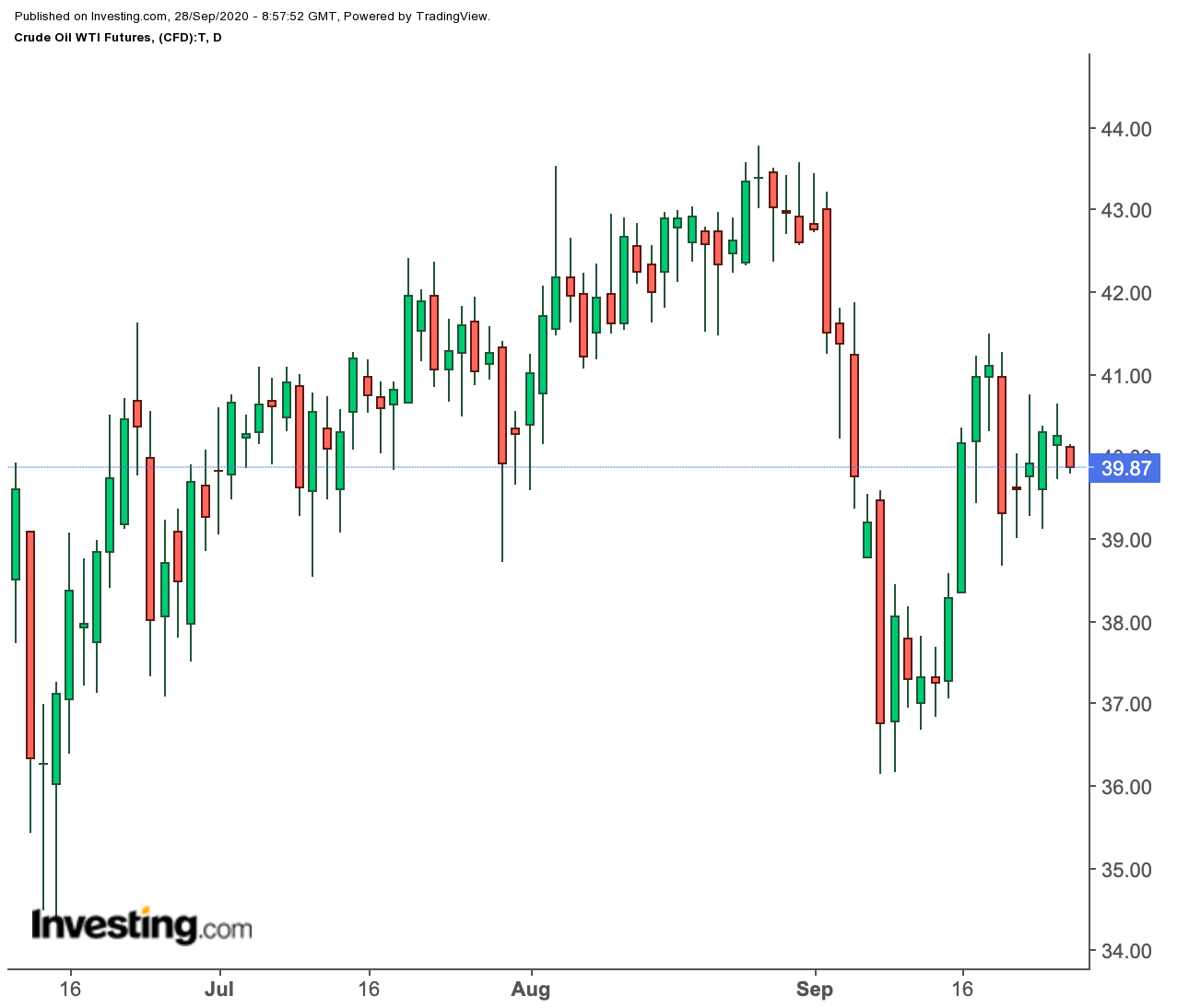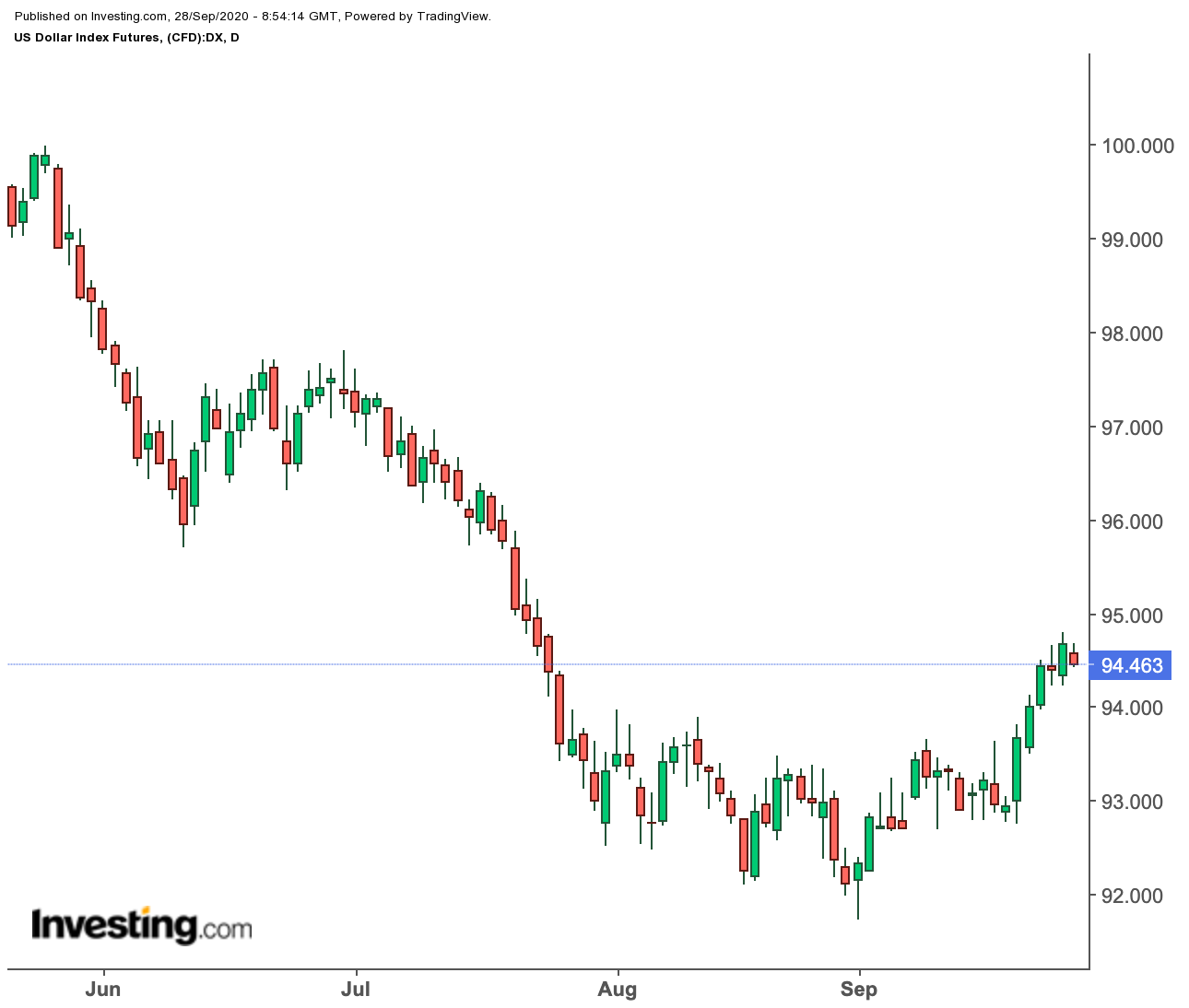From OPEC, the oil exporters’ cartel, to Vitol, the energy trading powerhouse, the verdict seems to be the same: dark clouds are gathering over the crude market.
What isn’t clear is what downside this will have on prices in the near-term.
It’s a similar predicament for gold: the yellow metal is near two-month lows with charts indicating further weakness. Yet, with the dollar looking like it could give back some of its mind-blowing strength of the past two weeks, there’s no telling how far down the tape gold could go.
Two wildcards this week for macro/gold trades: the first debate on Tuesday between President Donald Trump and his challenger Joe Biden for the Nov. 3 presidential election, and Friday’s nonfarm payrolls for August.
As though that wasn’t enough, U.S. CFTC data released Friday showed speculators held a big net short position in the greenback, near its highest levels in almost a decade.
Gold chartist Dhwani Mehta said in a post on FXStreet:
“Risk sentiment and U.S. dollar dynamics will continue to play out, in the face of the looming coronavirus risks and U.S. fiscal stimulus uncertainty,”
suggesting a test of the critical $1,863 barrier for the yellow metal.
OPEC Sees Higher Supply Near-Term
But back to oil: Mohammad Barkindo, secretary-general of the Organization of Petroleum Exporting Countries, or OPEC, said, in remarks at the G20 Energy Ministers virtual meeting that commercial oil stocks in the developed world could stay well above the five-year average in the third quarter of this year.
“The expected supply and demand balance would result in OECD commercial stocks standing well above the latest five-year average in Q3/2020,”
Barkindo said, referring to oil inventories in rich countries grouped under the Organization for Economic Co-operation and Development.
The OPEC secretary-general, however, expects OECD crude stocks to fall in the fourth quarter, to reach around 123 million barrels, or just above the five-year average.
Vitol Rules Q4 Rally In Oil
Vitol, the world's biggest independent oil trader, sees little scope for an oil rally in the fourth quarter as global demand was slowing due to new coronavirus-related restrictions, according to Bloomberg. Vitol Group executive committee member, Chris Bake said:
"The conventional wisdom going into the fourth quarter was that things were going to improve.....it doesn't feel like we have a huge catalyst and demand is more uncertain."
Several European countries have recently reimposed restrictions on travel and social gathering due to a resurgence of coronavirus cases across the continent.
Crude prices logged their third weekly loss in four on Friday, as analysts warned of a gloomier near term for the market after an unexpected surge in production in politically-liberated Libya added to concerns about demand.
New York-traded West Texas Intermediate, the key indicator for U.S. crude price, settled the week down 2.1%. By 1:38 PM in Singapore (5:39 GMT), WTI was off by another 1.2%, or 45 cents, at $39.80 per barrel.
London-traded brent crude, the global benchmark for oil, was down 44 cents, or 1%, at $41.97. by 2:45 PM ET (18:45 GMT). Last week, brent lost 3%.
Since the mid-September OPEC+ meeting that more or less reaffirmed production cuts till the year-end, crude prices have been pulled both ways.

Lending support was the notion of the output cuts that could better balance the market, helped further by supportive U.S. crude stockpile draws.
Libyan Situation Looms As New Headache For OPEC
Weighing on the market was an unexpected peace deal between warring factions in Libya that could bring up to a million barrels more to the market.
Libya's National Oil Corp said it expects production to rise to around 260,000 barrels per day, or bpd, by next week, up from some 100,000 bpd before the blockade of its oil ports and oilfields lifted by forces aligned to renegade general Khalifa Haftar.
Analysts estimate now that total Libyan production could reach 550,000 bpd by the end of the year and nearly a million bpd by mid-2021. All that for a country that did not export a single barrel from January due to the civil war forced by Haftar. At its peak in 2008, Libya produced nearly 1.8 million bpd.
The shifting market dynamics could force OPEC back to the drawing board, to figure out what to do with all that unexpected new supply. Marco Dunand, Murcuria's co-founder and chief executive told Bloomberg:
“We see a fair amount of oil going into ships, into floating storage, now. We are filling up both tankers as floating storage and onshore tanks in September. There has been a slow-down in the global rebalancing process.”
Reports emerged earlier this month that commodity traders were chartering more tankers to store crude oil offshore, sparking concern we could see something like a repeat of this spring when hundreds of millions of barrels of unsellable oil had to be dumped on tankers because onshore storage was full. After the lockdowns ended, oil sales began improving but not for jet fuel, which remains the worst demand component.
Gold Just Had Worst Week In 6 Months
Gold, meanwhile, is emerging from its worst week in six months, losing almost 5% last week, after a knockout punch from nemesis dollar, which again proved to be champ in the latest round of global risk aversion.
“This was a week gold bulls will want to forget, the worst one since the scramble for crash that took place when the coronavirus unraveled financial markets in March,”
Ed Moya, macro analyst at online trading platform OANDA, said Friday.
Spot gold, which reflects real-time trades in bullion, finished last week down 4.6%. By 2:06 PM in Singapore (6:06 GMT) on Monday, it was down $5.84, or 0.3%, at $1,856.92.
On the futures side, U.S. gold for December delivery was down $5.48, or 0.3%, at $1,856.92. It finished last week down 4.9%.
“The next target on the downside could be the little area of consolidation from mid-July between $1,794 and $1,847.34,”
Rajan Dhall, another gold chartist, said on FX Street on Friday.
“The indicators are still looking bearish with the Relative Strength Index still hugging the oversold area.”
Notwithstanding the punishing week, both measures for gold showed an average year-to-date gain of 20%.
Gold Could Lose More, Pending Tuesday Debate, Friday Jobs’ Data
For gold bulls, it was a reflection of the haven’s strength in the face of adversity. For bears, it was a signal that there was a lot more to profit from selling the yellow metal down on the back of the dollar rally.
After an early plunge in March, when it crashed with equities in a liquidation shock triggered by the novelty of COVID-19 lockdowns, gold had a phenomenal wave higher.
From a five-month low of $1,451.50, spot gold hit record highs of $2,073 by the first week of August.

But it ran into a severe resistance thereafter, as weakness in other currencies and renewed U.S.-China tensions propelled the dollar as a favorite haven instead.
“We are seeing a risk-off environment taking hold, which means that the dollar continues strengthening and there is a lot of pressure on gold prices in the near-term,”
said Howie Lee, an economist at OCBC Bank.
The Dollar Index, or DX, which tracks the greenback’s performance versus six currencies, was down 0.2% at 94.537, off from a two-month high of 94.795 set on Friday. DX was up 2% on the week and nearly 3% higher on the month although it remains down more than 1% on the year.
Charts show that the dollar’s strength is unlikely to yield much below the 94 level this week, especially with Tuesday’s presidential debate and Friday’s jobs numbers on the slot.

The dollar could spike if challenger Biden, who is leading in the polls, performs well at the debate. The greenback could also move higher if nonfarm payrolls for August come in higher than the 850,000 additions forecast after August’s jobs growth of 1.37 million.
